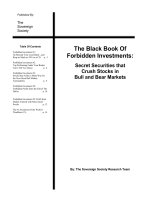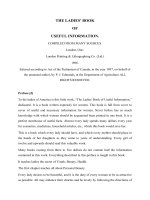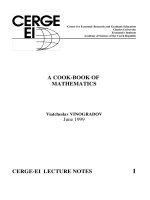- Trang chủ >>
- Khoa Học Tự Nhiên >>
- Vật lý
david darling - the universal book of mathematics
Bạn đang xem bản rút gọn của tài liệu. Xem và tải ngay bản đầy đủ của tài liệu tại đây (11.34 MB, 395 trang )
The Universal Book
of Mathematics
From Abracadabra
to Zeno’s Paradoxes
David Darling
John Wiley & Sons, Inc.
The Universal Book
of Mathematics
The Universal Book
of Mathematics
From Abracadabra
to Zeno’s Paradoxes
David Darling
John Wiley & Sons, Inc.
This book is printed on acid-free paper. ●
∞
Copyright © 2004 by David Darling. All rights reserved
Published by John Wiley & Sons, Inc., Hoboken, New Jersey
Published simultaneously in Canada
No part of this publication may be reproduced, stored in a retrieval system,
or transmitted in any form or by any means, electronic, mechanical,
photocopying, recording, scanning, or otherwise, except as permitted under
Section 107 or 108 of the 1976 United States Copyright Act, without either
the prior written permission of the Publisher, or authorization through
payment of the appropriate per-copy fee to the Copyright Clearance Center,
222 Rosewood Drive, Danvers, MA 01923, (978) 750-8400, fax (978) 646-8600,
permission should be addressed to the Permissions Department, John Wiley &
Sons, Inc., 111 River Street, Hoboken, NJ 07030, (201) 748-6011, fax
(201) 748-6008.
Limit of Liability/Disclaimer of Warranty: While the publisher and the author
have used their best efforts in preparing this book, they make no
representations or warranties with respect to the accuracy or completeness of
the contents of this book and specifically disclaim any implied warranties of
merchantability or fitness for a particular purpose. No warranty may be
created or extended by sales representatives or written sales materials. The
advice and strategies contained herein may not be suitable for your situation.
You should consult with a professional where appropriate. Neither the
publisher nor the author shall be liable for any loss of profit or any other
commercial damages, including but not limited to special, incidental,
consequential, or other damages.
For general information about our other products and services, please contact
our Customer Care Department within the United States at (800) 762-2974,
outside the United States at (317) 572-3993 or fax (317) 572-4002.
Wiley also publishes its books in a variety of electronic formats. Some content
that appears in print may not be available in electronic books. For more
information about Wiley products, visit our web site at www.wiley.com.
Library of Congress Cataloging-in-Publication Data:
Darling, David J.
The universal book of mathematics : from abracadabra to Zeno’s paradoxes /
David Darling.
p. cm.
Includes bibliographical references and index.
ISBN 0-471-27047-4 (cloth: alk. paper)
1. Mathematics—Encyclopedias. I. Title.
QA5 .D27 2004
510'.3—dc22 2003024670
Printed in the United States of America
10 9 8 7 6 5 4 3 2 1
or on the web at www.copyright.com. Requests to the Publisher for
Mathematics is not a careful march down a
well-cleared highway, but a journey into a strange
wilderness, where the explorers often get lost. Rigor
should be a signal to the historian that the maps have
been made, and the real explorers have gone elsewhere.
—William S. Anglin
But leaving those of the Body, I shall proceed to such
Recreation as adorn the Mind; of which those of the
Mathematicks are inferior to none.
—William Leybourn (1626–1700)
The last thing one knows when writing a book is what
to put first.
—Blaise Pascal (1623–1662)
Contents
Acknowledgments ix
Introduction 1
Mathematics Entries A to Z 3
References 359
Solutions to Puzzles 369
Category Index 373
vii
Acknowledgments
M
any people have helped me enormously in assem-
bling this collection of mathematical oddities,
delights, whimsies, and profundities. Thanks especially
go to Jan Wassenaar (www.2dcurves.com) for drawing
many of the plane curves that are featured in the book;
Robert Webb (www.software3d.com) for numerous pho-
tos of his wonderful, homemade polyhedra; Jos Leys
(www.josleys.com) for his mesmerizing fractal artwork;
Xah Lee (www.xahlee.org) for a variety of ingenious digi-
tal imagery; Sue and Brian Young at Mr. Puzzle Australia
(www.mrpuzzle.com.au) and Kate and Dick Jones at
Kadon Enterprises (www.gamepuzzles.com) for their ad-
vice and photos of puzzles from their product lines and
personal collections; Gideon Weisz (www.gideonweisz
.com) and Istvan Orosz for stunning recursive and ana-
morphic art images; my good friend Andrew “Dogs”
Barker for stimulating discussions and the solution to
one of the problems; William Waite for pictures from his
antique math collection; and Peter Cromwell, Lord &
Lady Dunsany, Peter Knoppers, John Lienhard, John
Mainstone, David Nicholls, Paul and Colin Roberts,
Anders Sandberg, John Sullivan, and others for their
valuable contributions.
I’m greatly indebted to Stephen Power, senior editor,
and to Lisa Burstiner, senior production editor, at John
Wiley & Sons, for their encouragement and unfailing
attention to detail, and even proffering of alternative,
clever solutions to some of the problems in the book.
Any errors that remain are entirely my own responsibil-
ity. Thanks also to my marvelous agent, Patricia Van der
Leun. And last but most of all, thanks to my family for
letting me pursue a career that is really a fantasy.
ix
Introduction
shining student, I realize what a profound effect those
two deeply imaginative, thoughtful men had on my
future career. I did become an astronomer. I did perse-
vere with math to a certain level of competence. But,
much more than that, my curiosity was fired by the won-
derful and weird possibilities of these subjects: curved
space, Möbius bands, parallel universes, patterns in the
heart of chaos, alternative realities. These strange possi-
bilities, and a thousand others, make up the stuffing of
this book. If you want a comprehensive, academic dictio-
nary of mathematics, look elsewhere. If you want rigor
and proof, try the next shelf. Herein you will find only
the unusual and the outrageous, the fanciful and the fan-
tastic: a compendium of the mathematics they didn’t
teach you in school.
Entries range from short definitions to lengthy articles
on topics of major importance or unusual interest. These
are arranged alphabetically according to the first word of
the entry name and are extensively cross-referenced.
Terms that appear in bold type have their own entries. A
number of puzzles are included for the reader to try; the
answers to these can be found at the back of the book.
Also at the back are a comprehensive list of references
and a category index. Readers are invited to visit the
author’s Web site at www.daviddarling.info for the latest
news in mathematics and related subjects.
Y
ou are lost in a maze: How do you find your way out?
You want to build a time machine, but is time travel
logically possible? How can one infinity be bigger than
another? Why can’t you drink from a Klein bottle? What
is the biggest number in the world to have a proper
name, and how can you write it? Who claimed he could
see in the fourth dimension? And what does “iteration”
mean? And what does “iteration” mean?
Mathematics was never my strong point in school, but
because I wanted to become an astronomer, I was told
to stick with it. Fortunately, in my last two years be-
fore heading off to university, I had a wonderful old-
fashioned, eccentric teacher (he actually wore a black
gown when teaching), called Mr. Kay (known to one and
all as “Danny”), who would suddenly divert from the
chalk and blackboard to ask, “But how did the universe
come to be asymmetric—that’s what I want to know,” or
“These imaginary numbers are very interesting; in part,
because they are so remarkably real.” During lunch-
break, Danny and the senior chemistry teacher, Mr. Erp
(whose nickname I need hardly spell out), would always
meet in the chemistry prep room for a game of chess.
They looked and acted very much like characters from a
Wellsian science fiction tale, and I sometimes imagined
them musing on formulas for invisibility or doorways to
higher dimensions. At any rate, though I was never a
1









